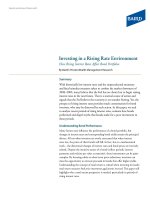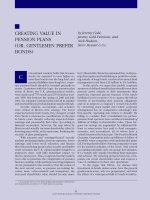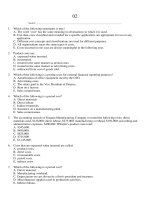Lecture Managerial accounting: Creating value in a dynamic business environment (10th edition): Chapter 3 - Ronald W. Hilton, David E. Platt
Bạn đang xem bản rút gọn của tài liệu. Xem và tải ngay bản đầy đủ của tài liệu tại đây (493.03 KB, 27 trang )
Chapter 3
Product Costing and Cost
Accumulation in a Batch
Production Environment
Copyright © 2014 McGraw-Hill Education. All rights reserved. No reproduction or distribution without the prior written consent of McGraw-Hill Education.
Product and Service Costing
Financial
Accounting
Product costs are used
to value inventory and
to compute cost of
goods sold.
Managerial
Accounting and
Cost Management
Product costs are used
for planning, control,
directing, and
management decision
making.
32
Flow of Costs in Manufacturing Firm
Work-in-Process Inventory
Direct material cost
Direct labor cost
Manufacturing overhead
Finished Goods Inventory
Product cost transferred
when product is finished
Cost of Goods Sold
Income Summary
Expense closed into
Income Summary at end
of accounting period
33
Types of Product-Costing Systems
Process
Costing
Job-Order
Costing
Used for production of large, unique, high-cost items.
Built to order rather than mass produced.
Many costs can be directly traced to each job.
TWO TYPES:
Job-shop operations
Products manufactured in very low volumes or one at
a time.
Batch-production operations
Multiple products in batches of relatively small
quantity.
34
Types of Product-Costing Systems
Process
Costing
Job-Order
Costing
Typical job-order cost applications:
Special-order printing
Building construction
Also used in the service industry
Hospitals
Law firms
35
Types of Product-Costing Systems
Process
Costing
Job-Order
Costing
Used for production of small, identical, low cost
items.
Mass produced in automated continuous
production process.
Costs cannot be directly traced to each unit of
product.
Typical process cost applications:
Petrochemical refinery
Paint manufacturer
Paper mill
36
Manufacturing Overhead Costs
Overhead is applied to jobs using a predetermined overhead
rate (POHR) based on estimates made at the beginning of
the accounting period.
POHR =
Budgeted manufacturing overhead cost
Budgeted amount of cost driver (or activity base)
Overhead applied = POHR × Actual activity
Based on estimates, and
determined before the
period begins
Actual amount of the allocation
base, such as direct labor hours,
incurred during the period
37
Manufacturing Overhead Costs
Overhead is applied to jobs using a predetermined
overhead rate (POHR) based on estimates made at the
beginning of the accounting period.
POHR =
Budgeted manufacturing overhead cost
Budgeted amount of cost driver (or activity base)
Overhead applied = POHR × Actual activity
Recall the Aluminum Boat example where:
Overhead applied = $30 per DLH × 600 DLH = $18,000
38
Job-Order System Cost Flows
Let’s examine the
cost flows in a
job-order costing
system. We will
use T-accounts
and start with
materials.
39
Job-Order System Cost Flows
Raw Materials
•Material
Purchases
•Direct
Material
•Indirect
Material
Work in Process
(Job-Cost Record)
•Direct
Material
Mfg. Overhead
•Indirect
Material
310
Job-Order System Cost Flows
Next let’s add
labor costs and
applied
manufacturing
overhead to the
job-order cost
flows. Are you
with me?
311
Job-Order System Cost Flows
Wages Payable
•Direct
Labor
•Indirect
Labor
Work in Process
(Job-Cost Record)
•Direct
Material
•Direct
Labor
Mfg. Overhead
•Indirect
Material
•Indirect
Labor
312
Job-Order System Cost Flows
Wages Payable
•Direct
Labor
•Indirect
Labor
Mfg. Overhead
•Indirect •Overhead
Material Applied to
Work in
•Indirect
Process
Labor
Work in Process
(Job-Cost Record)
•Direct
Material
•Direct
Labor
•Overhead
Applied
If actual and applied
manufacturing overhead are
not equal, a year-end
adjustment is required. We
will look at the procedure to
accomplish this later.
313
Job-Order System Cost Flows
Now let’s
complete the
goods and sell
them. Still with
me?
314
Job-Order System Cost Flows
Work in Process
(Job-Cost Record)
•Direct
Material
•Direct
Labor
•Overhead
Applied
•Cost of
Goods
Mfd.
Finished Goods
•Cost of
Goods
Mfd.
•Cost of
Goods
Sold
Cost of Goods Sold
•Cost of
Goods
Sold
315
Job-Order System Cost Flows
Let’s return to
AFB Company
and see what we
will do if actual
and applied
overhead are not
equal.
316
Overhead Application Example
Actual Overhead costs for the year: $5,050,000
Actual direct labor hours worked for the year: 170,000
Applied Overhead = POHR × Actual Direct Labor Hours
Applied Overhead = $30.00 per DLH × 170,000 DLH = $5,100,000
Applied overhead exceeds actual overhead by
$50,000
This difference is called overapplied overhead.
317
Overapplied and Underapplied
Manufacturing Overhead
$50,000
may be allocated
to these accounts.
$50,000 may be
closed directly to
cost of goods sold.
OR
Work in
Process
Finished
Goods
Cost of
Goods Sold
Cost of
Goods Sold
AFB Company’s
Method
318
Overapplied and Underapplied
Manufacturing Overhead
AFB’s Cost
of Goods Sold
for the year
Actual Overhead
overhead Applied
costs
to jobs
Unadjusted
Balance
$50,000
Adjusted
Balance
AFB’s
Mfg. Overhead
for the year
$5,050,000
$50,000
$5,100,000
$50,000
overapplied
319
Overapplied and Underapplied
Manufacturing Overhead Summary
Alternative 1
If Manufacturing
Overhead is . . .
UNDERAPPLIED
(Applied OH is less
than actual OH)
OVERAPPLIED
(Applied OH is greater
than actual OH)
Allocation
Alternative 2
Close to Cost
of Goods Sold
INCREASE
Work in Process
Finished Goods
Cost of Goods Sold
INCREASE
Cost of Goods Sold
DECREASE
Work in Process
Finished Goods
Cost of Goods Sold
DECREASE
Cost of Goods Sold
320
Schedule of Cost of Goods Manufactured
Schedule of Cost of Goods Manufactured
Direct material:
Raw material inventory, beginning
Add: Raw material purchases
Raw material available for use
Deduct: Raw material, ending
Raw material used
$xxx
xxx
$xxx
xxx
$xxx
Direct labor
Manufacturing overhead
Indirect material
Indirect labor
Other actual overhead charges
Total actual manufacturing overhead
Add: Overapplied overhead
or Deduct: Underapplied overhead
Overhead applied to work-in-process
Total manufacturing costs
Add: Work-in-process inventory, beginning
Subtotal
Deduct: Work-in-process inventory, ending
Cost of goods manufactured
xxx
$xxx
xxx
xxx
$xxx
xxx
xxx
$xxx
xxx
$xxx
xxx
$xxx
321
Schedule of Cost of Goods Sold
Schedule of Cost of Goods Sold
Finished goods inventory, beginning
Add: Cost of goods manufactured*
Cost of goods available for sale
Deduct: Finished goods inventory, ending
Cost of goods sold
Add: Underapplied overhead
or Deduct: Overapplied overhead
Cost of goods sold (adjusted)
$xxx
xxx
$xxx
xxx
$xxx
xxx
$xxx
* From Cost of Goods Manufactured Schedule
322
Actual and Normal Costing
Actual direct material
and direct labor
combined with
actual overhead.
Actual direct material
and direct labor
combined with
predetermined overhead.
Using a predetermined rate makes it
possible to estimate total job costs sooner.
Actual overhead for the period is not
known until the end of the period.
323
Two-Stage Cost Allocation
Stage One:
Costs assigned
to pools
Cost pools
Indirect
Labor
Indirect
Materials
Other
Overhead
Department
1
Department
2
Department
3
324
Departmental Overhead Rates
Stage One:
Costs assigned
to pools
Cost pools
Stage Two:
Costs applied
to products
Indirect
Labor
Indirect
Materials
Other
Overhead
Department
1
Department
2
Department
3
Direct
Labor
Hours
Machine
Hours
Raw
Materials
Cost
Products
Departmental Allocation Bases
325









